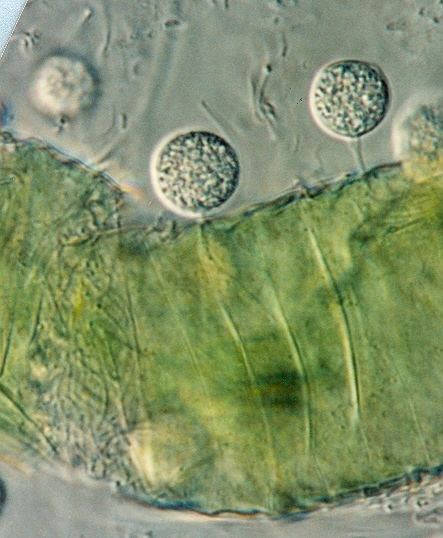Kingdom Fungi | Rank Order | |
 | ||
Similar Chytridiales, Batrachochytrium dendrobatidis, Chytridiomycetes, Chytriomyces, Blastocladiomycota | ||
Rhizophydiales are an important group of chytrid fungi. They are found in soil as well as marine and fresh water habitats where they function as parasites and decomposers.
Contents
Role in the environment
Rhizophydiales are parasites of a range of organisms, including invertebrates, other chytrids and algae, and they may have a role in natural control of aquatic populations, especially phytoplankton. One member, Rhizophydium graminis, is a parasite of wheat roots, but causes no extensive damage to the plant. The only documented cases of a chytrid parasitizing vertebrates are Batrachochytrium dendrobatidis and Batrachochytrium salamandrivorans, members of this order. They are highly destructive pathogens of frogs and salamanders respectively.
The majority of the described saprotrophic species of this order are biodegraders of pollen, with only a few growing on keratin, chitin, and cellulose. The transformational role of the Rhizophydiales in aquatic food webs is little studied but recently more recognized.
Life history
Their thalli (=bodies) consist of two parts: an absorptive branching rhizoidal system that contains no nuclei and a multinucleate sporangium that ranges in shape from spherical, to oval, to pear-shaped, and to multi-lobbed. The rhizoids attach the thallus to a substrate (food source) and absorbs nutrients. When the thallus is fully grown, the sporangium releases numerous, unwalled, uninucleate-zoospores, each bearing a single posteriorly directed flagellum.
The zoospore has to use its own stored food reserves (lipids and glycogen) as it swims until it attaches to a suitable host or substrate, absorbs its flagellum, produces a wall around itself, grows a germ tube that penetrates the substrate, and develops into a new thallus. Zoospores of parasitic chytrids use light and chemical cues to locate hosts. Zoospores of Rhizophydium littoreum, a parasite of marine green algae, are positively phototactic toward blue light, a mechanism that might assure that zoospores swim to the photic zone where its host resides. Zoospores of both R. littoreum and B. dendrobatidis exhibit chemotaxis to specific sugars, proteins and amino acids, also a mechanism by which zoospores might detect signals to potential hosts.
Sexual reproduction is more rarely reported and occurs when two adjacent sporangia function as gametangia with one transferring all of its cytoplasmic contents into the other, resulting in the development of a thick-walled, lipid-laden resting spore.
Taxonomic classification
The Rhizophydiales is an order of fungi that includes the following genera:
The following families have been established:
Biodiversity
New species and genera are still being discovered in this order. A member of this order, Kappamyces, was the first phylogenetic genus of a chytrid circumscribed based primarily on monophly demonstrated in molecular sequence analysis and confirmed with unique zoospore structure Coralloidiomyces digitatus defied the original view held that the thallus of members of the Rhizophydiales was conservative. Collected from submersed mud at the edge of an oligotrophic lake in southern Argentina near the Andes in Patagonia, C. digitatus has a thallus with a sporangium shaped like a coral.
